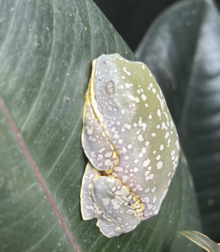$190.00 – $850.00
Your orders are shipped seamlessly between countries
* Delivery services subject to availability
Your payments are secure with our private security network.
It is found in the Amazonian lowlands in Brazil, Colombia, Ecuador, and Peru, and possibly in Bolivia.

Amazon Fringed Leaf Frog for sale can be distinguished from other frogs of Cruziohyla by the following characteristics. Adult males measure 53–66 mm (2.1–2.6 in) and adult females 68–76 mm (2.7–3.0 in) in snout–vent length. The head is slightly wider than it is long. The snout is sharply truncate in lateral view.
The fingers and toes are webbed. The hind margin of the tarsus bear extensive dermal appendages forming irregular spurs. The dorsum has uniform dark green dorsal background coloration interspersed with irregular-shaped large pale blue-grey lichenose blotches.
The flanks have narrow black lines. The undersides and concealed surfaces of the flanks and legs are yellow. When adhered to a surface, the yellow coloration becomes concealed which can aid in camouflage.
Amazon Fringed Leaf Frog for sale displays a burgundy pigmentation at night. This ability to rapidly color-adapt is mainly caused by levels of the hormone, intermedin, and its effects on chromatophore structure. The dermal chromatophore unit includes xanthophores, iridophores, and melanophores, which function together to display or inhibit certain coloring.
The movement of melanosomes to melanophore fingers conceals the light-reflecting iridisphore layer, dictating a darker pigmentation at night. Whereas, the absence of melanosomes in the fingers allows for rapid blanching.

Cruziohyla craspedopus can be distinguished from other frogs of Cruziohyla by the following characteristics. Adult males measure 53–66 mm (2.1–2.6 in) and adult females 68–76 mm (2.7–3.0 in) in snout–vent length. The head is slightly wider than it is long.
The snout is sharply truncate in lateral view. The fingers and toes are webbed. The hind margin of the tarsus bear extensive dermal appendages forming irregular spurs.
The dorsum has uniform dark green dorsal background coloration interspersed with irregular-shaped large pale blue-grey lichenose blotches. The flanks have narrow black lines. The undersides and concealed surfaces of the flanks and legs are yellow. When adhered to a surface, the yellow coloration becomes concealed which can aid in camouflage.
Cruziohyla craspedopus displays a burgundy pigmentation at night. This ability to rapidly color-adapt is mainly caused by levels of the hormone, intermedin, and its effects on chromatophore structure.
The dermal chromatophore unit includes xanthophores, iridophores, and melanophores, which function together to display or inhibit certain coloring. The movement of melanosomes to melanophore fingers conceals the light-reflecting iridisphore layer, dictating a darker pigmentation at night. Whereas, the absence of melanosomes in the fingers allows for rapid blanching.

| age | Froglets, Juveniles, Adults |
|---|---|
| sex | male, female |
You must be logged in to post a review.





PAY WITH CRYPTOCUTTENCY AND GET 25% DISCOUNT Dismiss
Reviews
There are no reviews yet.